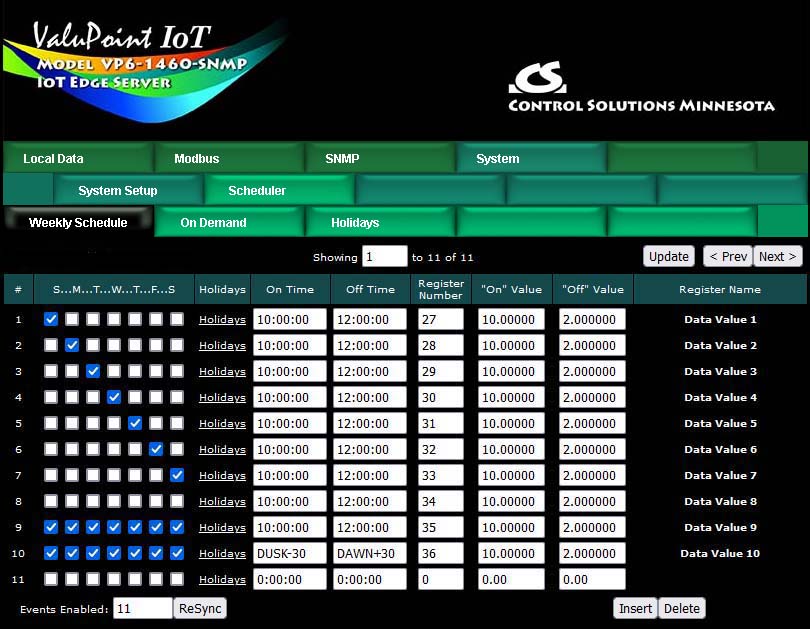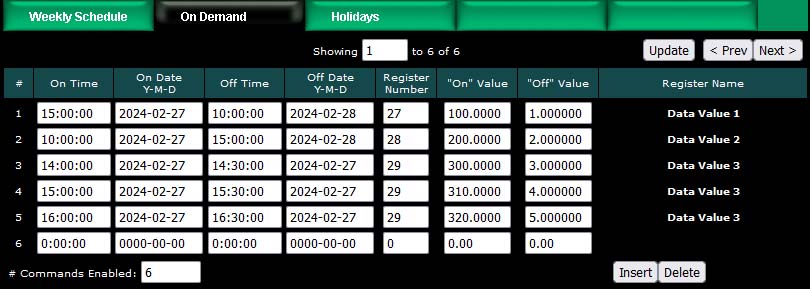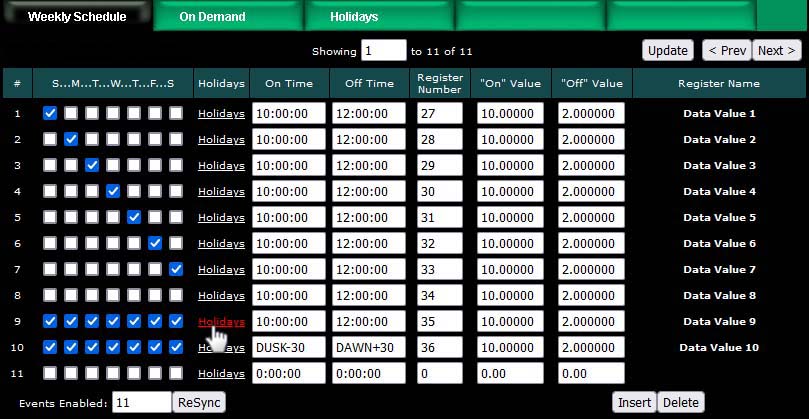
 |
The ValuPoint becomes more useful when control functions can be combined with monitoring. One element of control that is often useful is the ability to schedule things to happen at certain times on certain days. The scheduler makes that possible.
Scheduling is done in a very generic and simple way. A register you select will change value according to a schedule you provide. From there, you can use the client to write that register to some external Modbus device to cause action according to your schedule.
The scheduler does require access to an SNTP server in order to know what the current time and date are. Be sure to configure NTP on the Network setup page. If SNMP is not an option, you can also use the internal battery backed real time clock but it will be up to you to be sure it is set correctly.
The weekly schedule allows you to specify that something should happen at a certain time of certain days of the week. It can be one day, multiple days, or every day.
The days of the week start with Sunday in the left column. Simply check the boxes for those days you want action. Then select on and off time of day using 24-hour format. Select a register number, and its "on" and "off" value.
The "on" state will be that period that falls between On Time and Off Time. Any other time is "off". If multiple lines are used for the same day and same register, they should be organized with later times last and they will be processed sequentially.
Using the example illustrated below, local register 27 will be set to a value of 10 from 10:00AM until noon on Sunday, and be set to a value of 2 at all other times. And so forth.

Note the ReSync button at the bottom. If you have made changes to the scheduler, ReSync will cause everything about the schedule to be re-evaluated and registers updated accordingly. Normally, registers are written only when the schedule says it is time to change. The evaluation is made at the start of the configured time period. Therefore, if you have made a new schedule entry that says a register should be "on" now, you will need to hit the ReSync button to cause that to happen now.
Click Update to register your changes. The "Events Enabled" simply sets the scope of the web page display. If you are just starting out and want to see a page of 10 unused entries, set this to 10 and update. If you have many entries, use Next and Prev to scroll through the list. Insert will insert a new blank entry before the entry number in the Showing box at the top. Delete will delete the entry number you enter in the Showing box at the top.
The scheduler also provides the opportunity to schedule something to happen just one time on a given day or days. Instead of day of week, a date is provided here. Other than selection of day, the On Demand scheduler works the same as Weekly scheduler (except there are no holidays for On Demand).
Using the example illustrated below, local register 27 will be set to a value of 100 starting at 3:00PM February 27, 2024, and remain at that value until 10:00AM February 28. At all other times, local regiseter 27 will be set to 1. And so forth.

Entries applied to the same register number will be processed sequentially. Register 29 in the above example will be set to a value of 3 prior to 2:00PM Feb. 27. Then from 2:00PM to 2:30PM on Feb. 27, it will be set to a value of 300. From 2:30PM to 3:00PM, the value will be 3. From 3:00PM to 3:30PM, the value will be 310. From 3:30PM to 4:00PM, the value will be 4. From 4:00PM to 4:30PM, the value will be 320. Any time after 4:30PM Feb. 27, the value will be 5. On October 1, the value in register 29 will still be 5.
Click Update to register your changes. The "# Commands Enabled" simply sets the scope of the web page display. If you are just starting out and want to see a page of 10 unused entries, set this to 10 and update. If you have many entries, use Next and Prev to scroll through the list. Insert will insert a new blank entry before the entry number in the Showing box at the top. Delete will delete the entry number you enter in the Showing box at the top.
Sometimes you want a weekly schedule to not apply on a holiday, or maybe you want something to only happen on a holiday (although that would be nearly the same as On Demand). The holiday processing in the scheduler allows exceptions to the weekly schedule.
Start by creating a Holiday on the Holidays tab. Give it a name, start time and date, and end time and date. Most often the start time for a holiday will be 0:00:00 and end time will be 23:59:59 so that it means "all day". You may create up to 32 holidays.

To incorporate a holiday into a weekly schedule entry, click on that line's Holidays link.

The available holidays will be listed. To add a holiday, click on the holiday in the Available list and click the Add button. To remove a holiday previously added, click on the holiday in the Selected list and then click the Remove button. Once you have added a holiday or two, select whether to include or exclude.
The effect of exclude is to temporarily, effectively, uncheck that day of the week. The effect of include is to temporarily, effectively, check that day of the week. In the example below, regardless of what day of the week it is, if this day happens to be the holiday, the "On" value will not be applied between 10:00AM and noon.

Note that in the following example, no days of the week are selected but a holiday is selected as included. This is effectively an On Demand scheduled event for that holiday. The "On" value will be applied on this holiday, regardless of day of week, between 10:00AM and noon (assuming the holiday is defined as all day - if the holiday starts at 3:00PM, then the "On" value would not be applied and this entry in the schedule will never do anything.)

If you were looking closely at the first example in this section, you may have noticed one peculiar entry.

Suppose you are scheduling lights to come on when it gets dark outside. One way of doing that is with a light sensor. Another way is by scheduling, but then you have to keep changing the on and off times throughout the seasons. The astronomical clock feature of this scheduler will keep changing the on and off times for you when you use "DUSK" and "DAWN" as entries. In the example above, register 36 will be set to a value of 10 thirty minutes before sundown, and returned to a value of 2 thirty minutes after sunrise. The more likely scenario would be an on value of 1 and off value of 0 to switch a switch somewhere.
Note that in order for the astronomical clock to work correctly in your location, you must set the latitude and longitude for the location on the Network setup page, NTP section. You will also see the currently calculated sunrise and sunset times displayed there.